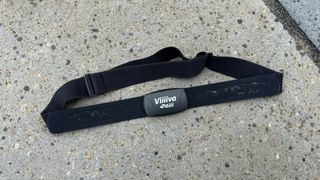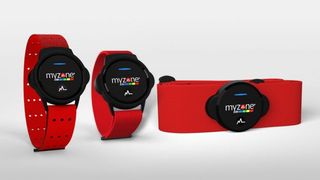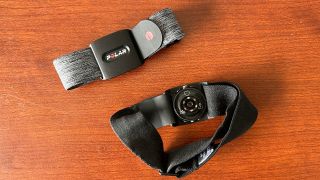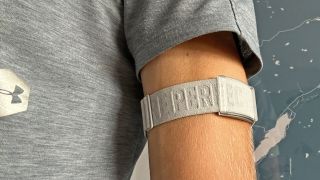The Best Heart Rate Monitors For Workouts
Keen on tracking your ticker? Here are the best heart rate trackers to guide your training

A heart rate monitor is now a staple feature on wrist-worn wearables, and these devices’ optical heart rate monitors are reasonably accurate for tracking your heart rate 24 hours a day. However, optical heart rate monitors worn on the wrist during workouts can struggle to get an accurate reading, which is why I always recommend using an external heart rate monitor, usually worn on the chest or upper arm. These can link up with the best running watches and some leading fitness trackers to provide more accurate data.
You’ll find a range of excellent heart rate monitors below, along with a thorough explanation from an expert from Polar, one of the industry leaders, of how the different types of heart rate monitors work and why chest straps are generally the most accurate.
How I Test Heart Rate Monitors
You can trust Coach
I use each heart rate monitor I test to track my training over a period of two to three weeks. Most of my workouts are runs—I run five or six times a week—with some cycles and strength sessions as well. If testing an armband I’ll check its readings against a chest strap, and when testing chest straps I check them against an armband, though I expect a chest monitor to be more accurate, and sometimes another chest strap. This is usually the Polar H10, which I have found to be highly accurate over long-term use.
The Best Heart Rate Monitors

Specifications
Reasons to buy
Reasons to avoid
The H10 is accurate, comfortable and able to connect via Bluetooth, ANT+ and 5kHz, allowing two Bluetooth connections at a time and unlimited ANT+ connections. The battery lasts for up to 400 hours before it needs to be replaced, which means even keen athletes will get through most of a year before having to replace it (a CR2025 replacement battery is widely available and cheap).
It’s also the most comfortable chest strap I’ve worn, a consideration that shouldn’t be underestimated. I found the buckle-like attachment preferable to the usual slip and loop you get on chest straps, and I haven’t had any skin irritation from the H10 while using it for runs almost every day for months.
The downside to the H10 is that most of its features are available on the cheaper Polar H9 strap, which only allows one Bluetooth connection and is a little less comfortable than the H10, though just as accurate. The H10 also lacks the advanced features of straps like Garmin’s HRM-Pro Plus, which tracks running technique stats, as well as your pace and distance when on a treadmill. So, while the H10 remains the gold standard for accuracy and comfort, there is better value to be found elsewhere for most people.
Read more in our Polar H10 review

Specifications
Reasons to buy
Reasons to avoid
There are cheaper chest straps in Coospo’s range that offer even more value if you don’t mind using a coin battery, but the convenience of the 50-hour rechargeable battery life of the H9Z means it gets my vote. It’s still excellent value and has proved very accurate during my testing, even during hard interval runs with frequent spikes and dips in HR, and while it’s not the most comfortable strap when compared with the likes of Polar’s H9 and H10, it was fine for long runs.
The functions of the H9Z are, oddly and inconveniently, split between two apps, Coopso Ride and Heartool. You can’t use the Coospo H9Z for swimming and it doesn’t offer extras like workout storage or running technique stats that you do get on some more expensive straps, but for the basics of broadcasting your HR to an app, bike computer or watch it’s an excellent, convenient option.
Read more in our Coospo H9Z Heart Rate Monitor review

Specifications
Reasons to buy
Reasons to avoid
The 4iiii Viiiiva is first and foremost a reliably accurate heart rate monitor—it consistently matched the readings from a Polar H10 throughout more than 30 hours of testing. It’s also great value and has internal storage which can hold up to 65 hours of workout data. It disappoints on battery life, though, which is only 160 hours according to 4iiii but drained even faster than that estimate for me.
Its main appeal will be to those who use a lot of sensors that rely on ANT+ connectivity, because the Viiiiva can bridge from ANT+ to Bluetooth. This means if you have multiple ANT+ sensors you want to connect to a device that only uses Bluetooth, the Viiiiva will bridge the gap. While Bluetooth is standard on modern sensors, some older ones only use ANT+, and the bridging feature will prove invaluable in that case.
Read more in my 4iiii Viiiiva Heart Rate Monitor review

Specifications
Reasons to buy
Reasons to avoid
The MZ-Switch can be used to track your heart rate from your wrist, arm or chest. It contains an ECG sensor for measurements on the chest—the most accurate position—plus an optical PPG sensor for tracking from your arm or wrist, which many find more comfortable and convenient than a chest strap.
Wherever you wear it, you’ll be earning MyZone Effort Points (MEPs) during your exercise, and these are earned at a faster rate when you’re working in higher heart rate zones. It’s another way to motivate yourself, particularly during HIIT sessions, and some gym chains have partnered with MyZone to broadcast your heart rate and zone to screens during classes to help you work at the right intensity.
The MZ-Switch also boasts an impressive battery life for such a small, rechargeable device, lasting three to six months (the optical sensor uses more battery than the ECG). It connects easily to any device via ANT+ or Bluetooth, and I found swapping the sensor between the included straps for your chest, wrist and arm a piece of cake.
The only real downside here is the price. It’s more cost-effective to buy a separate arm and chest strap tracker if you don’t plan on using the MyZone app and earning those MEPs.
Read more in our MyZone MZ-Switch review

Specifications
Reasons to buy
Reasons to avoid
Polar has two great armband HR trackers in its range, the OH1 and Verity Sense. The Verity Sense is more expensive, but has big advantages over the OH1. The battery life is longer, at 30 hours (vs 12), the Bluetooth range is twice as big at 150m, it has a larger memory for storing workouts, and it’s waterproof to 50m (in contrast to 30m for the OH1). The Verity Sense comes with a clip so you can attach it to your goggles for measurements in the water.
Arm straps offer more accuracy than a wrist-based monitor, and they’re more convenient and comfortable than a chest strap. The Verity Sense slips on easily and in my testing I found it impressively close to a chest strap’s readings in running, strength and cycling sessions, with just a small amount of lag in its readings at the start and end of intervals.
It connects via ANT+ and Bluetooth, and the lights system on the device shows the three training modes available. The first is for when you want to pair it with a device like a watch, the second is for recording a workout directly on the Verity Sense itself to sync to an app later, and the third is a swimming mode.
Read more in our Polar Verity Sense review

Specifications
Reasons to buy
Reasons to avoid
The HRM-Pro Plus is Garmin’s top heart rate chest strap, replacing the HRM-Pro in its line-up. The Pro Plus does all the great things the Pro did, including measuring advanced running stats like running power, ground contact time and vertical oscillation, which you can see on compatible Garmin watches live during your runs. It also works in the water and will sync your HR data to the Garmin app once you’ve finished swimming.
There’s nothing to choose between the software of the Pro and Pro Plus. The Pro Plus adds the ability to measure indoor running distance and pace, but this will come to the Pro in an update. However, the key upgrade you get here is a new battery compartment that you can open without using a screwdriver. Not only does this make changing the battery easier than on the Pro, but it also reduces the chances of you breaking the strap, which was a common complaint about the Pro and something I managed to do when using the Pro for an extended period.
Read more in our Garmin HRM-Pro Plus review

Specifications
Reasons to buy
Reasons to avoid
The Coros Heart Rate Monitor is not as advanced a device as the Polar Verity Sense in that it only broadcasts via Bluetooth, not ANT+, doesn’t have a swimming mode and can’t store workouts. However, it does a great job of tracking your heart rate accurately and in my experience is the easiest monitor to use, which has made it my go-to option.
This is largely due to the buttonless design. Just slip the Coros monitor on your arm and it turns on and links up to your connected watch. Take it off and it turns itself off again. The battery life is good, at 38 hours of active tracking or 80 days in standby mode, which is slightly longer than the Verity Sense.
If you’ve no need for extra features and prefer an armband to a chest strap, the Coros Heart Rate Monitor is a convenient option—and cheaper than the Polar Verity Sense.
Read more in my Coros Heart Rate Monitor review
Heart Rate Monitors Buyer’s Guide
To find out more about how chest straps and optical heart rate monitors work, and advice on which is more accurate, we spoke to Polar research center director Jyrki Schroderus and Richard Robinson, senior product manager at Garmin.
How do heart rate chest straps work?
“Chest straps measure electric signals arising from heart activity, which is the same thing as if you were in hospital and you put on the wires for an electrocardiogram (ECG),” says Schroderus. “The strap measurement is a simplified version of the hospital measurement with only one channel, one connection, but we are able to measure the heart rate from that. In the hospital there are 12 leads, and it makes a map of your electrocardiogram activity.
“The cardiac activity comes actually from your heart muscle, and the tiniest cells that we have in our heart. When they operate, very small electric activity is generated and when we combine all of them together, it’s still very low, but we get a measurable signal from the skin. You can see a difference in your voltage, basically.
“If you take the strap you can see the black pads, which actually receive the electric signal from your chest. You have to have a very good contact at your chest area, so that the electric signal gets into the electronics of the device.”
What are the pros and cons of a chest strap?
“Comfort is one issue because it results in pressure on your chest area, but it’s very accurate, and it’s very tolerant of disturbances which arise from motion,” says Schroderus. “It’s a hard environment to make the measurement: there’s motion at your chest, there’s lots of sweat too so all the electric characteristics of your skin are changing from dry to sweaty skin. There’s also flapping of the shirt, perhaps because you are riding a bicycle and there’s wind coming against you.
“So even though the strap looks very simple, there is a lot of engineering behind it and the price point of the device is very low.”
How do optical heart rate monitors work?
“It’s called photoplethysmography or PPG measurement, which is basically measuring the blood pulse in your skin,” says Schroderus.
“It uses LED lights and a sensor. Light penetrates into your skin and when it’s under your skin, your blood pulse changes the power of the light which comes back to the sensor. It measures your blood – it doesn’t measure your heart directly.”
What are the pros and cons of optical heart rate monitors?
“The advantage is that you can make the measurement anywhere where you have skin – your forehead, lower arm, upper arm, anywhere,” says Schroderus. “It’s very handy.
“The measurement is, basically, not as accurate as the chest measurement. There are a couple of reasons for that. First, the location of the sensor could be your lower arm and there is a lot of motion in your arm area. The most catastrophic place for PPG is actually your wrist – it’s a very hostile measurement place. That’s why there are lots of complaints about the quality of the measurement with the wrist devices. We know that and we have lots of people here solving the problem!
“If you put it on the upper arm, it’s almost as good as the ECG-based measurement for heart rate because the motions are not that violent.”
Why are heart rate monitors less accurate in cold conditions, and what can you do to improve accuracy?
“Optical HRM works by detecting blood flow in your wrist,” says Robinson. “When it is cold your body restricts flow to the extremities, ie your hands and feet, and so a sufficient warm-up is needed to increase the blood flow and ensure accurate readings. Also, keeping your hands warm will help the blood flow, so gloves can help in cold weather.
“Chest straps can be challenged initially when the weather is cold and dry as it takes longer for your body to sweat, preventing the conductivity needed for the electrical signals. A simple solution is to dampen the contact points or use an HRM Gel. This increases conductivity and ensures a signal from the start until you have warmed up and are sweating naturally.”
Are optical straps accurate for taking heart rate variability (HRV) measurements?
“With an ECG measurement, you can do HRV measurements in almost any situation,” says Schroderus. “But if you take a PPG measurement, optical heart rate, it’s practically impossible to measure that during motion. If you want to calculate some more advanced parameters, like breathing frequency, you can measure that during your run from your chest, but it’s not possible with the optical heart rate.
“But if you are at rest, we can measure the PPG PP interval – the separation between successive heartbeats. That’s why we can measure sleep and stress parameters at night with a wrist device.”
Which heart rate monitor is the most accurate?
I’ve tested a lot of chest and optical heart rate monitors from different brands over thousands of miles of running, and I’d say that chest strap monitors are considerably more accurate than the sensors on watches.
While I’ve picked out the Polar H10 as the most accurate chest strap overall—and use it as my HRM running almost every day to compare with other devices—the accuracy of other top chest straps is comparable. As long as you wet the strap to get good conductivity for readings, chest straps are accurate in general, even if the Polar still just about gets my vote as the most reliable overall.
Get the Coach Newsletter
Sign up for workout ideas, training advice, reviews of the latest gear and more.

Nick Harris-Fry is a journalist who has been covering health and fitness since 2015. Nick is an avid runner, covering 70-110km a week, which gives him ample opportunity to test a wide range of running shoes and running gear. He is also the chief tester for fitness trackers and running watches, treadmills and exercise bikes, and workout headphones.
